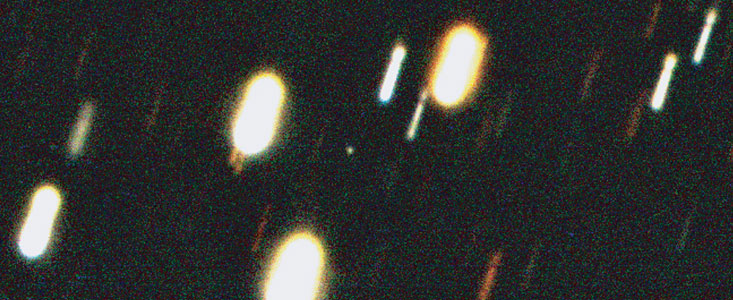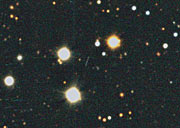Press Release
ESO's Telescope Takes Picture of ESA's Rosetta's Target, Comet 67P/Churyumov-Gerasimenko
2 March 2004
In the morning of March 2, the Rosetta spacecraft was launched on board an Ariane-5 launcher from the European Spaceport in Kourou, French Guiana. The European Space Agency (ESA) spacecraft will be the first to land on a comet.
Before the launch, and as a salute to their colleagues at ESA, astronomers used the New Technology Telescope at the European Southern Observatory (ESO) of La Silla in Chile to image Rosetta's target, Comet 67P/Churyumov-Gerasimenko, an approximately 4 kilometre size "dirty snowball" that orbits the Sun once every 6.6 years.
These new images show the object at a distance of approximately 670 million kilometres from the Sun - 4.5 times the distance from the Earth to the Sun.
These observations provide further confirmation that at this distance the activity on 67P/Churyumov-Gerasimenko is very low.
This is very good news for the mission, because it means that when Rosetta will meet in 2014 its target comet, at 790 million kilometres from the Sun, there will not be so much dust near the nucleus to hinder the landing.
Originally timed to begin about a year ago, Rosetta's journey had to be postponed. This delay meant that the original mission's target, Comet Wirtanen, which was observed two years ago by astronomers using ESO's Very Large Telescope could no longer be reached. Instead, a new target has been selected, Comet Churyumov-Gerasimenko.
The observations presented here are part of a continuous effort by astronomers to monitor Rosetta's target and provide the spacecraft controllers and the astronomers with very useful, regular updates, e.g., about the 'cometary weather' at the time of arrival.
More information
Additional information concerning ESA's Rosetta mission can be found on the dedicated ESA web site.
Links
About the Release
| Release No.: | eso0406 |
| Legacy ID: | Photo 06a-b/04 |
| Name: | 67P/Churyumov-Gerasimenko |
| Type: | Solar System : Interplanetary Body : Comet |
| Facility: | New Technology Telescope |
Our use of Cookies
We use cookies that are essential for accessing our websites and using our services. We also use cookies to analyse, measure and improve our websites’ performance, to enable content sharing via social media and to display media content hosted on third-party platforms.
ESO Cookies Policy
The European Organisation for Astronomical Research in the Southern Hemisphere (ESO) is the pre-eminent intergovernmental science and technology organisation in astronomy. It carries out an ambitious programme focused on the design, construction and operation of powerful ground-based observing facilities for astronomy.
This Cookies Policy is intended to provide clarity by outlining the cookies used on the ESO public websites, their functions, the options you have for controlling them, and the ways you can contact us for additional details.
What are cookies?
Cookies are small pieces of data stored on your device by websites you visit. They serve various purposes, such as remembering login credentials and preferences and enhance your browsing experience.
Categories of cookies we use
Essential cookies (always active): These cookies are strictly necessary for the proper functioning of our website. Without these cookies, the website cannot operate correctly, and certain services, such as logging in or accessing secure areas, may not be available; because they are essential for the website’s operation, they cannot be disabled.
Functional Cookies: These cookies enhance your browsing experience by enabling additional features and personalization, such as remembering your preferences and settings. While not strictly necessary for the website to function, they improve usability and convenience; these cookies are only placed if you provide your consent.
Analytics cookies: These cookies collect information about how visitors interact with our website, such as which pages are visited most often and how users navigate the site. This data helps us improve website performance, optimize content, and enhance the user experience; these cookies are only placed if you provide your consent. We use the following analytics cookies.
Matomo Cookies:
This website uses Matomo (formerly Piwik), an open source software which enables the statistical analysis of website visits. Matomo uses cookies (text files) which are saved on your computer and which allow us to analyze how you use our website. The website user information generated by the cookies will only be saved on the servers of our IT Department. We use this information to analyze www.eso.org visits and to prepare reports on website activities. These data will not be disclosed to third parties.
On behalf of ESO, Matomo will use this information for the purpose of evaluating your use of the website, compiling reports on website activity and providing other services relating to website activity and internet usage.
Matomo cookies settings:
Additional Third-party cookies on ESO websites: some of our pages display content from external providers, e.g. YouTube.
Such third-party services are outside of ESO control and may, at any time, change their terms of service, use of cookies, etc.
YouTube: Some videos on the ESO website are embedded from ESO’s official YouTube channel. We have enabled YouTube’s privacy-enhanced mode, meaning that no cookies are set unless the user actively clicks on the video to play it. Additionally, in this mode, YouTube does not store any personally identifiable cookie data for embedded video playbacks. For more details, please refer to YouTube’s embedding videos information page.
Cookies can also be classified based on the following elements.
Regarding the domain, there are:
- First-party cookies, set by the website you are currently visiting. They are stored by the same domain that you are browsing and are used to enhance your experience on that site;
- Third-party cookies, set by a domain other than the one you are currently visiting.
As for their duration, cookies can be:
- Browser-session cookies, which are deleted when the user closes the browser;
- Stored cookies, which stay on the user's device for a predetermined period of time.
How to manage cookies
Cookie settings: You can modify your cookie choices for the ESO webpages at any time by clicking on the link Cookie settings at the bottom of any page.
In your browser: If you wish to delete cookies or instruct your browser to delete or block cookies by default, please visit the help pages of your browser:
Please be aware that if you delete or decline cookies, certain functionalities of our website may be not be available and your browsing experience may be affected.
You can set most browsers to prevent any cookies being placed on your device, but you may then have to manually adjust some preferences every time you visit a site/page. And some services and functionalities may not work properly at all (e.g. profile logging-in, shop check out).
Updates to the ESO Cookies Policy
The ESO Cookies Policy may be subject to future updates, which will be made available on this page.
Additional information
For any queries related to cookies, please contact: pdprATesoDOTorg.
As ESO public webpages are managed by our Department of Communication, your questions will be dealt with the support of the said Department.


